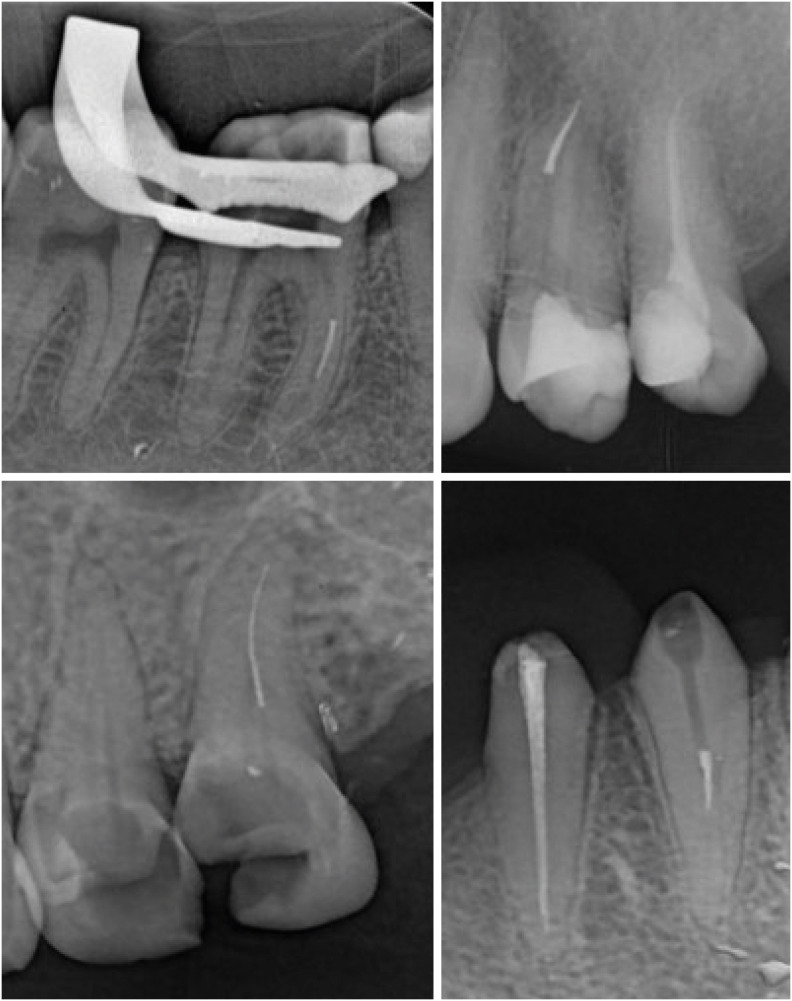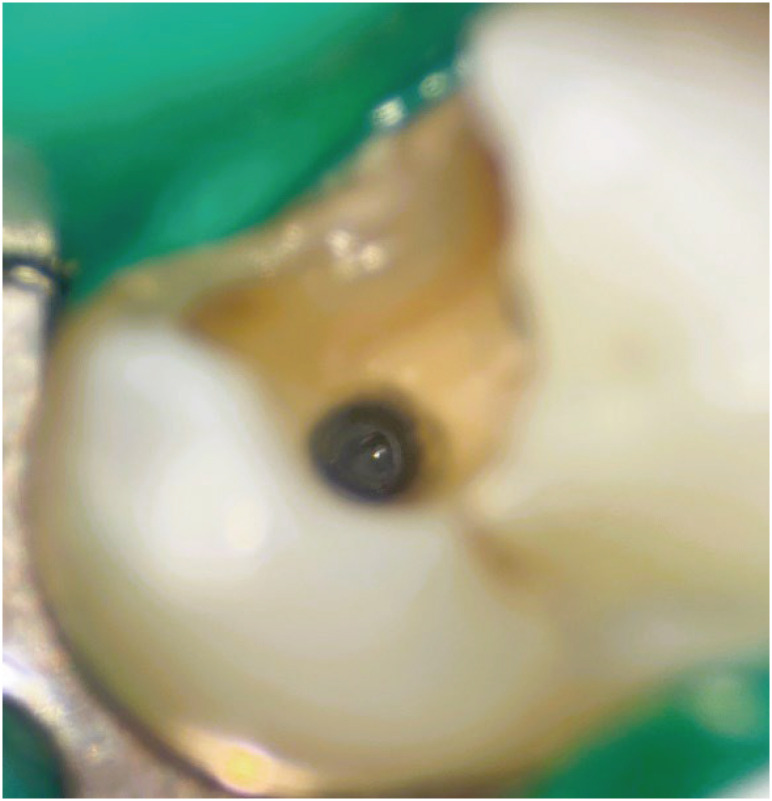Restor Dent Endod.
2023 Nov;48(4):e38. 10.5395/rde.2023.48.e38.
Investigation of fracture prevalence of instruments used in root canal treatments at a faculty of dentistry: a prospective study
- Affiliations
-
- 1Department of Endodontics, Faculty of Dentistry, Fırat University, Elazığ, Turkey
- 2Department of Endodontics, Faculty of Dentistry, Dicle University, Diyarbakır, Turkey
- KMID: 2548759
- DOI: http://doi.org/10.5395/rde.2023.48.e38
Abstract
Objectives
The aim of this study was to examine the use of hand or rotary files by pregraduation (fourth- and fifth-year) and postgraduate students in endodontic treatments and to determine the incidence of file fracture and the management of cases with broken instruments.
Materials and Methods
A total of 2,168 teeth undergoing primary endodontic treatment were included in this study. It was determined that 79 of these teeth resulted in broken tools. In the case of broken tools, the education level of the treating clinician, the tooth that was being treated, the canal and fracture level, the curvature of the tooth and the management of the broken instrument were recorded. Periapical radiographs of the patients were used to calculate curvature following the Schneider method.
Results
There was no significant difference in the incidence of broken tools according to education level (p > 0.05). The incidence of file fracture in molar teeth (73.4%) was higher than in other teeth (p < 0.05). More files were broken in the mandibular molar MB canal (20.25%) and in the apical third of the canals (72.1%). The risk of instrument fracture was high in teeth with moderate (44.3%) and severe (38%) curvature canals. The management of apically broken (80%) files mostly involved lefting (p < 0.05).
Conclusions
There was no statistically significant difference between fourth-year students, fifth-year students and postgraduate students in terms of instrument fracture.
Figure
Reference
-
1. Patnana AK, Chugh A, Chugh VK, Kumar P. The incidence of nickel-titanium endodontic hand file fractures: a 7-year retrospective study in a tertiary care hospital. J Conserv Dent. 2020; 23:21–25. PMID: 33223636.
Article2. Grossman LI. Guidelines for the prevention of fracture of root canal instruments. Oral Surg Oral Med Oral Pathol. 1969; 28:746–752. PMID: 5259460.
Article3. Parashos P, Messer HH. Rotary NiTi instrument fracture and its consequences. J Endod. 2006; 32:1031–1043. PMID: 17055902.
Article4. Gambarini G. Cyclic fatigue of ProFile rotary instruments after prolonged clinical use. Int Endod J. 2001; 34:386–389. PMID: 11482722.
Article5. Ankrum MT, Hartwell GR, Truitt JE. K3 Endo, ProTaper, and ProFile systems: breakage and distortion in severely curved roots of molars. J Endod. 2004; 30:234–237. PMID: 15085054.
Article6. Sattapan B, Nervo GJ, Palamara JE, Messer HH. Defects in rotary nickel-titanium files after clinical use. J Endod. 2000; 26:161–165. PMID: 11199711.
Article7. Tzanetakis GN, Kontakiotis EG, Maurikou DV, Marzelou MP. Prevalence and management of instrument fracture in the postgraduate endodontic program at the Dental School of Athens: a five-year retrospective clinical study. J Endod. 2008; 34:675–678. PMID: 18498887.
Article8. Abu-Tahun I, Al-Rabab’ah MA, Hammad M, Khraisat A. Technical quality of root canal treatment of posterior teeth after rotary or hand preparation by fifth year undergraduate students, The University of Jordan. Aust Endod J. 2014; 40:123–130. PMID: 25197021.
Article9. Yılmaz A, Gökyay SS, Dağlaroğlu R, Küçükay IK. Evaluation of deformation and fracture rates for nickel-titanium rotary instruments according to the frequency of clinical use. Eur Oral Res. 2018; 52:89–93. PMID: 30775708.
Article10. Iqbal MK, Kohli MR, Kim JS. A retrospective clinical study of incidence of root canal instrument separation in an endodontics graduate program: a PennEndo database study. J Endod. 2006; 32:1048–1052. PMID: 17055904.
Article11. Cheung GS, Bian Z, Shen Y, Peng B, Darvell BW. Comparison of defects in ProTaper hand-operated and engine-driven instruments after clinical use. Int Endod J. 2007; 40:169–178. PMID: 17305693.
Article12. Sonntag D, Delschen S, Stachniss V. Root-canal shaping with manual and rotary Ni-Ti files performed by students. Int Endod J. 2003; 36:715–723. PMID: 14641434.
Article13. Deepika G, Mitthra S, Anuradha B, Karthick A. Separated instruments—a mind-set between hard and rock: a review. J Evolut Med Dent Sci. 2017; 6:6077–6080.14. Field J, Cowpe J, Walmsley D. The Profile of Undergraduate Dental Education in Europe. Dublin: Association for Dental Education in Europe;2017.15. Davey J, Bryant ST, Dummer PM. The confidence of undergraduate dental students when performing root canal treatment and their perception of the quality of endodontic education. Eur J Dent Educ. 2015; 19:229–234. PMID: 25490882.
Article16. Ng YL, Mann V, Rahbaran S, Lewsey J, Gulabivala K. Outcome of primary root canal treatment: systematic review of the literature - Part 1. Effects of study characteristics on probability of success. Int Endod J. 2007; 40:921–939. PMID: 17931389.
Article17. Sonntag D, Stachniss-Carp S, Stachniss V. Determination of root canal curvatures before and after canal preparation (part 1): a literature review. Aust Endod J. 2005; 31:89–93. PMID: 16392729.
Article18. Wang NN, Ge JY, Xie SJ, Chen G, Zhu M. Analysis of Mtwo rotary instrument separation during endodontic therapy: a retrospective clinical study. Cell Biochem Biophys. 2014; 70:1091–1095. PMID: 24807841.
Article19. Siqueira JF Jr. Aetiology of root canal treatment failure: why well-treated teeth can fail. Int Endod J. 2001; 34:1–10. PMID: 11307374.
Article20. Panitvisai P, Parunnit P, Sathorn C, Messer HH. Impact of a retained instrument on treatment outcome: a systematic review and meta-analysis. J Endod. 2010; 36:775–780. PMID: 20416418.
Article21. Ungerechts C, Bårdsen A, Fristad I. Instrument fracture in root canals - where, why, when and what? A study from a student clinic. Int Endod J. 2014; 47:183–190. PMID: 23710943.
Article22. Gomes MS, Vieira RM, Böttcher DE, Plotino G, Celeste RK, Rossi-Fedele G. Clinical fracture incidence of rotary and reciprocating NiTi files: a systematic review and meta-regression. Aust Endod J. 2021; 47:372–385. PMID: 33410578.
Article23. Madarati AA, Watts DC, Qualtrough AJ. Factors contributing to the separation of endodontic files. Br Dent J. 2008; 204:241–245. PMID: 18327187.
Article24. McGuigan MB, Louca C, Duncan HF. Endodontic instrument fracture: causes and prevention. Br Dent J. 2013; 214:341–348. PMID: 23579132.
Article25. Shen Y, Coil JM, McLean AG, Hemerling DL, Haapasalo M. Defects in nickel-titanium instruments after clinical use. Part 5: Single use from endodontic specialty practices. J Endod. 2009; 35:1363–1367. PMID: 19801231.
Article26. Cunningham CJ, Senia ES. A three-dimensional study of canal curvatures in the mesial roots of mandibular molars. J Endod. 1992; 18:294–300. PMID: 1402588.
Article27. Wu J, Lei G, Yan M, Yu Y, Yu J, Zhang G. Instrument separation analysis of multi-used ProTaper Universal rotary system during root canal therapy. J Endod. 2011; 37:758–763. PMID: 21787484.
Article28. Kosti E, Zinelis S, Molyvdas I, Lambrianidis T. Effect of root canal curvature on the failure incidence of ProFile rotary Ni-Ti endodontic instruments. Int Endod J. 2011; 44:917–925. PMID: 21658071.
Article29. Suter B, Lussi A, Sequeira P. Probability of removing fractured instruments from root canals. Int Endod J. 2005; 38:112–123. PMID: 15667633.
Article30. Parashos P, Gordon I, Messer HH. Factors influencing defects of rotary nickel-titanium endodontic instruments after clinical use. J Endod. 2004; 30:722–725. PMID: 15448468.
Article31. Regan JD, Sherriff M, Meredith N, Gulabivala K. A survey of interfacial forces used during filing of root canals. Endod Dent Traumatol. 2000; 16:101–106. PMID: 11202864.
- Full Text Links
- Actions
-
Cited
- CITED
-
- Close
- Share
- Similar articles
-
- Selection of Nickel-Titanium Files according to the Clinical Procedure and Factors of File Fracture: A Narrative Review
- Retrieval of a separated nickel-titanium instrument using a modified 18-guage needle and cyanoacrylate glue: a case report
- Safe root canal preparation using reciprocating nickel-titanium instruments
- Predictor factors of 1-rooted mandibular second molars on complicated root and canal anatomies of other mandibular teeth
- Does minimally invasive canal preparation provide higher fracture resistance of endodontically treated teeth? A systematic review of in vitro studies





